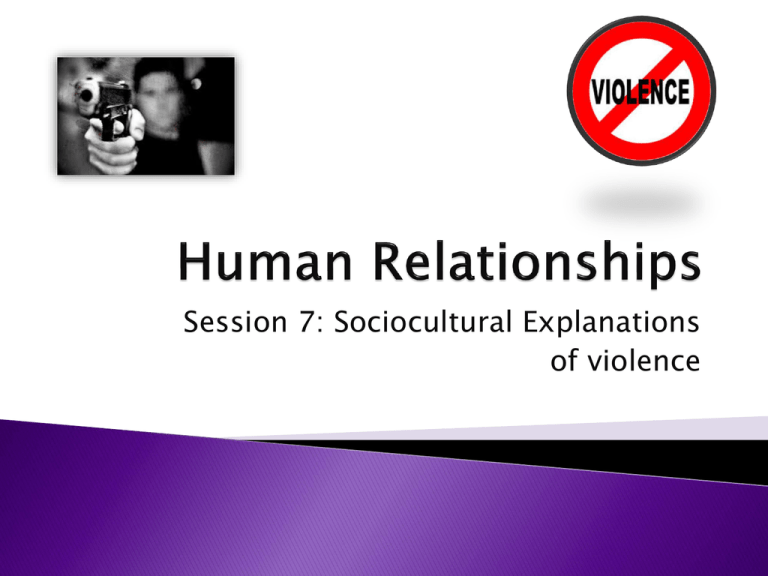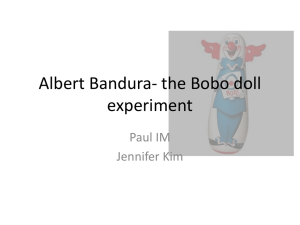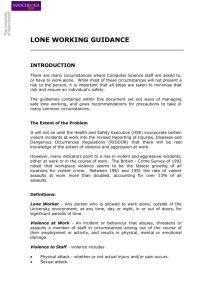File
advertisement

Session 7: Sociocultural Explanations of violence Evaluate sociocultural explanations of violence 1. 2. 3. 4. 5. 6. 7. Is violence ever justified? How old do you think the youngest murderer ever was? Give explanations of terrorism. What do you think are the reasons for school shootings? Will there ever be a nuclear war? Are humans less or more violent than we used to be? Why does violence sell? Violence: An aggressive act in which the perpetrator abuses individuals indirectly or directly (IB Textbook) “The intentional use of physical force or power, threatened or actual against oneself, another person, or against a group or community, which either results in or has a high likelihood of resulting in injury, death, psychological harm, maldevelopment or deprivation (World Health Organisation Examples of violence: Murder, bullying, war, genocide, domestic violence, suicide Social psychologists focus on social rules and roles, how groups affects attitudes and behaviour, why people obey authority, and how each of us is affected by other people Cultural psychologists examine how cultural rules and values – both explicit and implicit – affect people’s development, behaviour and feelings There are many sociocultural explanations for origins of violence but we will focus on just two: 1. Social learning theory 2. Deindividuation theory 1. Social learning theory as an explanation for origin of violence (Bandura, 1977) Write down everything you can remember about social learning theory Suggested people learn to behave violently (including violent attitude and norms) through direct experiences and through observing models SLT focuses on observational learning and modeling. Theory proposes that children learn to be violent due to exposure to violent models & because this violent behaviour is rewarded SLT has been applied to explain the development of aggression & intergenerational transmission of violence through a process of socialisation ◦ Children are influenced by socialisation factors such as the family, the immediate environment including peers & the media Social learning can be: ◦ direct (via instructions/explicitly teaching) ◦ Indirect (e.g. observing role models) Children who grow up in violent families and neighbourhoods where they watch models use violence & obtain benefits from it (e.g. power) may be likely to see violence as a legitimate means to get what they want or exert power over other people. Support for this proposition comes from the results of Bandura & Ross’ classic 1961 Bobo doll study Two aims: 1. To investigate whether children would imitate aggression modeled by an adult 2. To see if children were more likely to imitate same sex models Participants 72 children aged 3-6 years 36 boys and 36 girls Children were divided into 3 groups Groups were matched with regards to levels of aggression based on an evaluation from parents and teachers Condition Description Aggressive Model Exposed to adult models who showed aggression by bashing an inflatable “Bobo” doll Non-aggressive model Observed a non-aggressive adult who assembled toys for 10 minutes Control No model observed After watching the models, the children were placed in a room with toys Very soon, they were taken out of the room, being told that these toys were for other children and were then put into a room with the Bobo doll Results Children who had observed the aggressive model were significantly more aggressiveboth verbally and physically- towards the Bobo doll According to Bandura, the theory of social learning theory was demonstrated in the study, since the children showed signs of observational learning Results Bandura also observed that girls were more likely to imitate verbal aggression and boys were more likely to imitate physical aggression When boys observed women bashing the Bobo doll, they often made comments like “ladies shouldn’t do that!” Children were more likely to imitate same-sex models Low Ecological Validity Experiment has been criticised for low ecological validity. Not only was the study carried out in a laboratory, there were other factors which made the situation artificial: Only a brief encounter with the model Children were intentionally frustrated after they were put in toy room Could be argued study does little to demonstrate what happens if a child is repeatedly exposed to aggressive parents or violence on television Does aggression against a Bob doll indicate learned aggression in general or is it highly specific to this situation Other methodological issues Aggression modeled by adults was not completely standardised meaning children may have observed slight differences in aggression displayed Despite attempts to match participants on levels of aggression across groups, the evaluations were based on observations from teachers and parent which may not be accurate or reliable. Question of demand characteristics: children may have acted aggressively because they thought it would please the researcher Ethics Use of young children is ethically questionable Observing adult strangers act in an aggressive manner may have been frightening for children Teaching aggressive behaviour to children also questionable. No guarantee that if aggressive behaviour was learned that it would be reversible Qualitative study on girlfriend abuse among violent male youth in Canada Aim: to explore how young girlfriend abusers used violence to construct their masculinity. Study focused on how families and peer groups contributed to learning and identification with violent norms as part of establishing a masculine gender role Procedure: Purposeful sample of 30 abusive adolescent males from a large city in Canada All had pro-abusive beliefs, masculine ideals and admitted to using violence towards their girlfriends Mean age of boys was 15.6 years. 6 belonged to an ethnic minority & rest were white Many were gang members and most had dropped out of school early Semi-structured interviews were used to collect data Adolescents backgrounds had similar features. They had all been exposed to violent behaviour in the family and they saw this as justified and even necessary Their fathers all had rigid authoritarian beliefs (e.g. rigid gender roles) & all used violence to control family members or defend their honour All were abusive and used physical and sexual violence for same reasons as their fathers Boys said they had the right to use violence if girlfriends did not behave In some cases, fathers had given instructions on how to abuse women in particular situations Used a small and purposive sample so it is not possible to generalise Qualitative data gave in-depth insight into how the violent adolescents experienced the use of violence themselves Practical applications: research could be a starting point to design interventions to prevent violence, such as by providing positive role models (mentoring) as well as education and job opportunities Eron (1986): Found a positive correlation between number of hours of violence watched on television at the age of 8 and the level of aggression they demonstrated as teenagers, as well as the number of criminal acts as adults Charlton et al (2002) Conducted a natural experiment Island of St Helena in the Atlantic Ocean Aim: to investigate whether children would exhibit more aggressive behaviour after the introduction to the island in 1995 Procedure: children aged 3-8 were observed before and after the introduction of television Content analysis of TV showed level of violence on television matched what children in UK generally exposed to Behaviour observed through the use of video cameras that were set up in the playgrounds of 2 primary schools on the island Researchers also conducted interviews with teachers, parents and some of the older children Results: Analysis of hundreds of hours of videotape, backed up by interview data showed there was no increase in aggressive or anti-social behaviour. This was also the case after five years Parents and teachers said that antisocial behaviour was not accepted on the island and that there was a high degree of social control in the community. Shows that people may learn aggressive behaviour but may not exhibit it for different reasons. Social and cultural factors play a role in what behaviours are acceptable, so even though children had no doubt learned aggressive behaviour, they did not show it. This study does not necessarily disprove SLT but rather conflicts with results from the Bobo doll study In relation to SLT it may be explained that children from St Helena were not motivated to imitate the behaviour due to the norms of their society High ecological validity: study investigated a naturally occurring event as opposed to an artificial task Results of study do not question SLT but rather the results of Bandura and Ross (1961). Results also support the idea that people must be motivated to imitate behaviour. Empirical evidence that supports theory i.e. Bandura (1961), Totten (2003) Social norms of violence can be transmitted from parents to children as predicted by SLT SLT can be used to explain why adolescents use violence in marginalised social peer groups because it pays off in the form of status (reinforcement) Theory has practical applications for forming violence intervention programmes i.e. mentoring programmes SLT cannot explain how structural factors such as poverty contribute to establishing norms of male superiority Theory does not take individual differences into account like intelligence and personality Neglects biological factors. Some people may be more prone to violence due to genetic inheritance/brain damage 2. Deindividuation Theory "Creates a unique psychological state in which behaviour comes under the control of immediate situational demands and biological, hormonal urges. With inner restraints suspended behaviour is totally under external situational control; outer dominates inner" - Zimbardo According to the theory deindividuation is a psychological state aroused when individuals join crowds or large groups State is characterised by diminished awareness of self and individuality Being in a large group provides a degree of anonymity- allows individual to avoid responsibility for actions Hogg and Vaughan (2008) define deindividuation as: ‘a process whereby people lose their sense of socialised identity and engage in unsocialised, often antisocial behaviours’. 1. 2. 3. There are three key factors for deindividuation to occur: Anonymity Group Size Arousal Female undergraduate students asked to give electric shocks to another student to “aid learning” ½ participants wore bulky lab coats & hoods that hid their faces. They were spoken to in groups and never referred to by name. Other ½ wore their own clothes, were given large name tags to wear and were introduced to each other by name. Could also see each other when seated at shock machines Participants told something about learner prior to experiment either: “she is honest, sincere and warm” Or “she is conceited and critical” Results Hooded participants administered twice as many shocks & amount of shocks did not vaary according to the description of learner Participants wearing name-tags related the amount of shock to the description given Conclusions Those whose identity had been obscured more likely to give harsher punishment Deindividuation seemed to lowered their sense of self-consciousness and sense of accountability for behaviour Low ecological validity. Questionable whether results would be seen in routine everyday experiences There is, however, evidence that this reflects what happens in extreme political unrest or in the case of torture (Haritos-Fatouros, 2003) Ethical concerns that participants may have been subjected to undue stress which may have had a long term impact In order to address issue of ecological validity Diener carried out a naturalistic observation on children at Halloween Aim: to see if deindividuation had an effect on amount of candy children took when trick or treating One group of children asked for names and addresses and other were not. Some were in costumes, some were not Children were encouraged to take a single sweet Results Those who were individuated by providing their name took more than the single sweet in 8% of cases Those who were deinviduated by being dressed in a Halloween costume took more than one sweet in 80% of cases Conclusion: supports theory of deindividuation Could explain problems with trolling and cyberbullying Often people behave in a way that is more extreme online than they would in real life Empirical evidence that supports theory i.e. Zimbardo, Diener Could explain violence like football hooliganism, riots etc Deindividuation theory cannot explain how structural factors such as poverty contribute to violence Cannot explain acts of violence when deindividuation is not present- only explains one type of violence? Theory does not take individual differences into account like intelligence and personality Neglects biological factors. Some people may be more prone to violence due to genetic inheritance/brain damage Violence is complex and sociocultural explanations alone cannot fully explain violent behaviour. Need to take into account other factors such as biology and cognition Each of you will be assigned one of the biological explanations of violence to learn You will then be asked to share with the group






